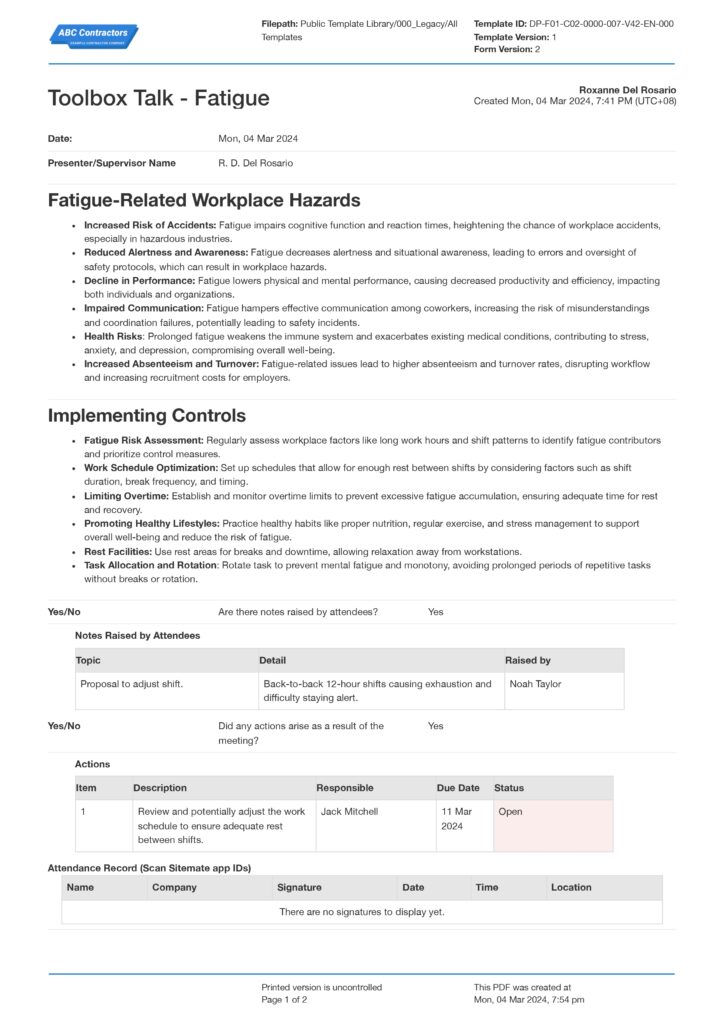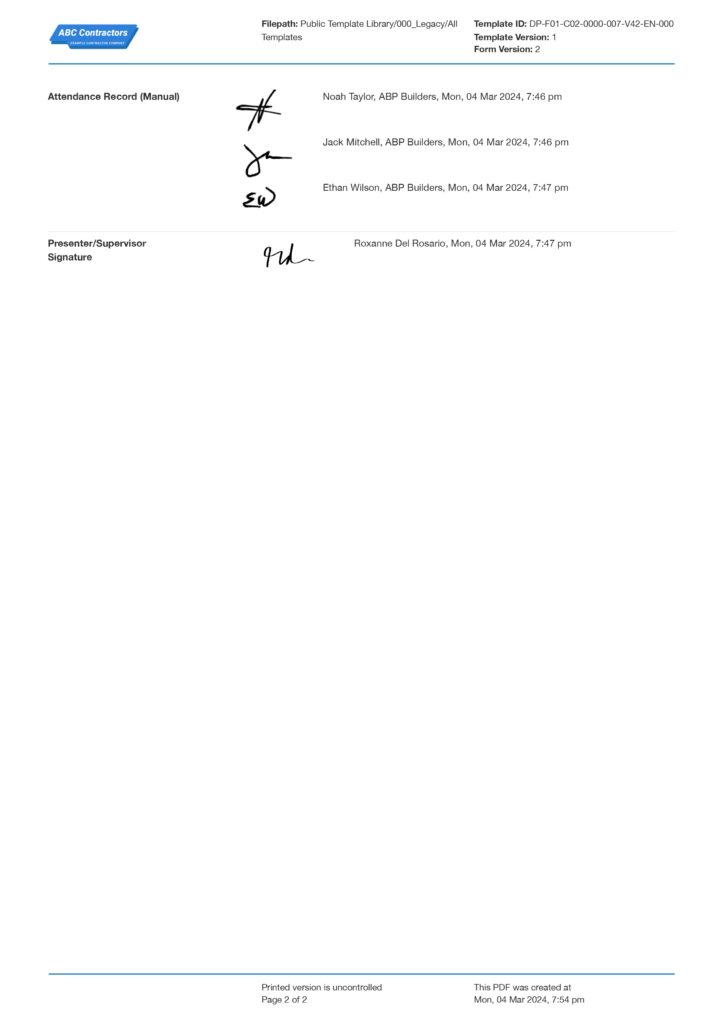Dashpivot Article – How to Prevent Fatigue in the Workplace
How to Prevent Fatigue in the Workplace
In this article, we will be covering how to prevent fatigue in the workplace focusing on construction and field-based companies, and providing you with some resources to help prevent fatigue in a proactive manner.

What is fatigue?
Have you ever had that feeling where no matter how long you’ve slept, you still feel overwhelmingly tired? Where you have tried every kind of hype and motivation you feed yourself, you still don’t have enough energy to pull yourself from this unexplainable weight that's pushing you down.
Well, that feeling is called ”fatigue”. Fatigue is a feeling of constant exhaustion.
To give you a better picture of how this feels, imagine that moment when you've been underwater for quite a long time and you try to hurry yourself to gasp for air. That first breath of air, where your body feels like it's burning from exhaustion as you deeply intake air like you never had it before. Imagine feeling that constantly everyday. That is when you can say that you are fatigued.
What causes fatigue?
The causes of fatigue are varrying. It can come from the constant overexertion of the physical body, can stem from different psychological factors, or can be a mix of both causes. To give you a better idea, here are some examples of both physical and psychological factors that could develop fatigue.
Physical
Lack of sleep: Sleep is the time where your body and mind get to rest, while it restores and recovers the whole body. For an average human adult, the required hours of sleep are atleast 7 hours or more . Sleep deprivation is very common for many adults who are working. They try to compromise sleep just to complete work-related deadlines. While it is an honourable thing to do, the truth is you’re damaging your most important asset to continuously do your work, which is your body. Constant sleep deprivation can cause fatigue and more serious health conditions.
Dehydration: Hydrating with water is crucial for human survival. One of water’s primary functions is to help blood cells deliver oxygen to your joints, muscles, and brain. Dehydration is the state where you lose fluid more than you intake it. In this state, the primary function of water gets compromised, making the person develop fatigue and leaving them vulnerable to other ailments like heat stress and kidney problems.
Constant physical exertion: One of the things that defines us humans is our ability to constantly defy our limits. It is often a celebrated trait since showing resilience to arrive at a breakthrough is inspiring and leads us to always do our best. However, in some cases, it might not be smart to apply this trait. In fields where a person needs to exert physical exertion, doing it constantly might negatively affect your body. It leads to fatigue, where the feeling is quite opposite to what was formerly said in this sentence.
Underlying illness: Being sick can greatly affect our limits in doing any physical activities. When certain illnesses like fever develop in a person, the natural response of the body is to fight off what is causing the infection. Having said that, your body consumes some of your energy as fuel for you to recover. With your energy consumed for recovering, you will start to feel weak. Having less energy plus the effects of the sickness will naturally cause fatigue.
Poor work-life balance: Lack of work-life balance refers to the inability to maintain a healthy balance between one's personal and professional lives. According to this, there is a greater emphasis placed on the importance of work than there is on maintaining pace with the activities that we wish to engage in in our personal lives. A lack of a healthy balance between work and personal life may result in exhaustion owing to the presence of chronic stress, excessive work hours, and insufficient time to recuperate both the mind and the body.
Psychological
Depression and Anxiety: Depression is a mental condition that causes a person to feel persistently unhappy and lose interest in everything, while anxiety is the state of being in a state of continual concern. These two mental disorders may have a big influence on a person's capacity to succeed and make it through life. With that being stated, fatigue is a normal consequence of both of these diseases.
Mental Overload: People might think that only physical activities can tire you out. However, using your brain also takes a lot of energy. You can simply prove this by trying to solve a difficult problem in your math class. There are times in our lives where we are pushed to constantly think and solve stuff mentally. However, doing this can cause mental overloading. This is a state where your brain shuts down because of too much information and emotion to process. When your brain shutsdown, your body will feel weary, and thinking might be too much of an activity, which is a symptom of fatigue.
Burnout: Excessive and sustained stress may lead to a condition of burnout, which is characterised by mental, bodily, and emotional weariness combined. When you are unable to satisfy the expectations that are constantly placed on you, you will experience feelings of being overwhelmed and emotionally exhausted. You start to lose the interest and drive that lead you to take on a certain task in the first place as the duration of the stress continues to increase.
Fatigue in the Workplace
If you have taken notice of the causes of fatigue above, you will notice that most of these come from the workplace. Being fatigued in the workplace can really affect the performance of workers, and expose them to safety and health hazards. To address this problem, establishments should recognise fatigue as a safety and health risk in the workplace and educate everyone about it. The best avenue to conduct such education on safety, is through toolbox talks.
Tool box talks are short, informal meetings that target safety discussions. It is also an open forum about safety issues and problems experienced by workers in the workplace. To conduct a successful toolbox talk, a toolbox form must be made. This contains a guideline on the topics to discuss, a field for the concerns raised during the meeting, and an area for signatures to officialize attendance. Conducting a toolbox talk about fatigue can help break the stigma on taking breaks and allow a person to recover. This promotes a more productive, safe, and healthy workplace.
Toolbox Talk Example
You can see an example of how to prevent fatigue in the workplace toolbox talk example

Use this free Toolbox talk format for free
How to Prevent Fatigue in the Workplace
Fatigue Risk Assessment in Demanding Conditions
Conduct regular risk assessments, especially in demanding environments with heat exposure, long shifts, tough conditions, etc., which are common.
Optimise Shifts in Continuous Operations
For operations that run continuously or in shifts, optimise schedules to align better with sleep cycles. Lots of mega projects are focused on night shifts given less traffic, etc., and having good handover times and shift handover processes can make a big difference in fatigue.
Limiting Overtime
Many high-risk work activities require high levels of concentration. People performing these activities should be fresh and not fatigued, so don't put overtime pressures on people performing these types of activities.
Rest Areas in Remote or Extensive Work Sites
Create deliberate rest areas on construction, mining, and similar sites, and denote rest areas on journey management plans if workers are performing long shifts on the road. Giving people a space where they can rest away from activity, noise, heat, stress, etc. provides them with a reprieve from fatigue factors.
Task Rotation in Repetitive Work Scenarios
Rotate tasks consistently when they are repetitive, such as on manufacturing lines and many other industrial activities. Implement timers and alarms to keep people moving on repetitive tasks.
Repetition impacts fatigue, especially mental fatigue, and rotating tasks helps.
Raise awareness around how to prevent fatigue in the workplace
Like all aspects of workplace safety, preventing fatigue in the workplace primarily involves raising awareness about it. Making people aware that the company sees fatigue as a problem and cares about preventing it gives workers permission to care about it too.
Conclusion
Fatigue can commonly occur in the workplace. To battle it, companies must first recognise it then educate people about it. When educating people, establishments could use the toolbox talk platform to discuss the entirety of fatigue in the workplace. Conducting a toolbox on fatigue is a mutual learning space where you teach the people about fatigue and how to avoid it, and you learn from your colleagues as well, from their experiences and concerns. With this exchange of knowledge and ideas, solutions to battle fatigue will be more solidified, creating a more productive, happy, safe, and healthy workplace.

Fatigue Management Report
Ensure you have identified your risk factors and are monitoring your fatigue management processes.

Safety Toolbox Talk
This toolbox talk template is quick and easy to complete and signoff on site, and keeps all of your toolbox talks neatly organised and professional.

Lone Working Risk Assessment
Ensure lone workers and their companies know the hazards, controls and precautions in place for lone workers.

